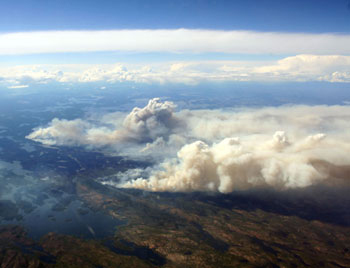Air pollution: It all depends on your perspective
Apr 9, 2010 - by Staff
Apr 9, 2010 - by Staff
David Hosansky | 12 April 2009 • There’s only so much air to go around. Since we inhale trillions of molecules with every breath, a few of them may have been exhaled by people who lived hundreds or thousands of years ago.
 Wildfires, such as this blaze in western Canada last summer, can create unhealthy levels of ozone pollution. (Photo by Cameron S. McNaughton.)
Wildfires, such as this blaze in western Canada last summer, can create unhealthy levels of ozone pollution. (Photo by Cameron S. McNaughton.)
To be sure, the atmosphere was different in the time of our forebears. It was, for the most part, less polluted (although some people, then and now, can breathe in too much smoke from cooking fires.) But how has the air changed in recent years? Is our atmosphere becoming more polluted, or less?
This question was raised by a Minneapolis Public Radio reporter, Dan Olson. I passed it along to Gabriele Pfister, a scientist who works in NCAR’s Atmospheric Chemistry Division and specializes in air pollution. She explains that there is no simple answer.
Clean air in North America and Europe, Pfister says, is on the upswing. This has to do, primarily, with pollution regulations and improved emission control equipment, like scrubbers on power plants. When Pfister and her colleagues study ground level ozone data from Environmental Protection Agency monitors from the early 1990s to the present, they find that many states and counties continue to experience unhealthy air – but the number of cases of very high ozone levels has gone down significantly.
However, that encouraging trend does not hold for other parts of the world, especially developing countries.
Emissions in Asia, for example, have been increasing steeply over recent decades due to increased economic growth and population. And, while there is little information about air quality from ground-based instruments in many developing countries, measurements from satellite confirm an increasing trend in emissions and air pollutants.
A 2009 study in Environmental Pollution led by Sachin Ghude at the Indian Institute of Tropical Meteorology used satellite data to study the trends in nitrogen dioxide levels over the past decade. The study team found that, in developing counties in Africa, the Middle East, and Asia, nitrogen dioxide levels increased by an annual average of about 2 percent. China set the pace, with an annual increase of 11 percent -- equivalent to emissions more than doubling every seven years.
 Gabriele Pfister. (©UCAR, photo by Carlye Calvin.)
Gabriele Pfister. (©UCAR, photo by Carlye Calvin.)
In contrast, levels decreased in North America (2 percent yearly) and Europe (1 percent).
“Now, with some parts of the world getting cleaner air and others more dirty, I could not tell you a global answer,” Pfister says.
What goes around comes around
It gets still more tricky, she explains, because we all share the same air, to some extent. In a U.S. city where most of the pollution is caused by local sources, emission controls will have a significant benefit on air quality. But what about a location (say a rural area at a higher elevation) that is more impacted by pollutants that blow in from another location? A 2007 study by the University of Washington’s Dan Jaffe in Atmospheric Environment attributed increasing pollution at some rural sites in the Pacific Northwest to sources elsewhere, either in the West or possibly as far away as Asia.
Moreover, about half of the world’s air pollution comes from wildfires, and a bad fire year can result in smoke that circles the globe. Pfister found that major fires in Alaska and western Canada in 2004 led to higher ground-level ozone levels thousands of miles downwind.
And when pollution moves, it’s not just horizontally. William Randel, the director of NCAR’s Atmospheric Chemistry Division, recently published a study in Science that found pollutants in Asia were being lofted up to the stratosphere during monsoon season. “The monsoon is one of the most powerful atmospheric circulation systems on the planet, and it happens to form right over a heavily polluted region,” Randel says.
Today, U.S. urban dwellers are familiar with air quality reports that tell you whether you can safely exercise outdoors that day or burn wood in your fireplace that night. Unfortunately, such reports don’t usually extend beyond 24 hours, since it’s still difficult to predict how the ebb and flow of pollution will dovetail with weather conditions more than a few hours in advance.
As they fine-tune instruments and computer models that capture the movements and evolution in pollutants, NCAR researchers are hoping to move toward longer-range “chemical forecasts.” Analogous to weather forecasts, these could eventually provide communities with several days’ notice of high levels of smog, particulate matter, or other air quality issues important to human health. Here’s a peek at how such forecasts could look, at least on a global scale.
While we may never enjoy global air as pristine as our ancestors breathed, at least we may be able to predict those times when pollution will be at its worst.